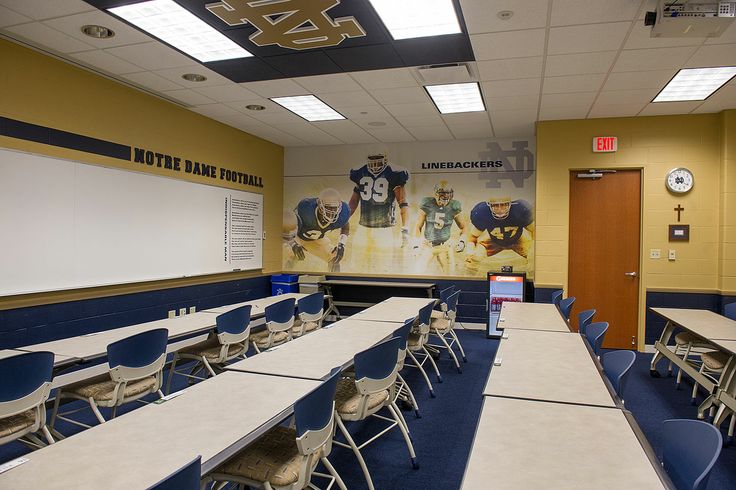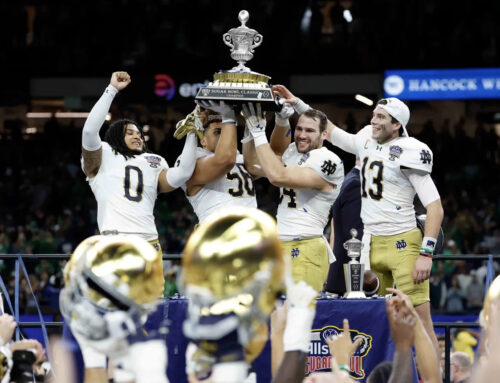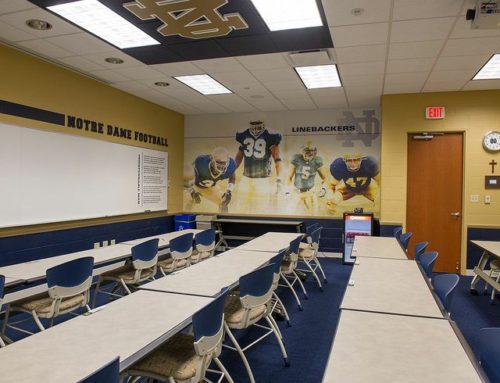The topic of interest for most Irish fans is likely the Run Pass Option (RPO) of Chip Long. They are exciting: you can throw a 20 yard pass on a running play; but also divisive: there can be decisions to throw while having a triple team at the line of scrimmage.
Ian Boyd wrote a nice short piece on some of the RPOs that Chip Long used at Memphis, and how Notre Dame rarely used RPOs in 2016. He was wrong on a couple minor points (Notre Dame had in-fact used at least two RPOs against Michigan State), but the analysis serves very well as a primer to this post.
Chip Long describes himself as ‘Pro-Style’ (if you look at the linemen’s stance there is no doubt), and his offense appears to be West Coast-like with a modern twist; however he does run some “Triple Option” in his offense.
From my impression of the 2017 Notre Dame Chip Long clinic talk, a “throw” on a RPO is considered a “run”; so before all the Sunday armchair quarterbacks complain that Kelly and Long aren’t running enough, a deeper look at the gamefilm is required than just the boxscore.
I had originally planned to break down several of the inside zone runs that Chip Long uses; however, Elko crammed the line of scrimmage and got a fair amount of penetration, and I did not feel that there were enough good cut ups.
If you are not a fan of bubbles for some reason, you are (somewhat) in luck. Chip Long greatly prefers to run fast screens instead of bubbles, but I captured one cutup where Long ran a bubble screen at Memphis.
Terminology
Some of this terminology may be general consensus, some of it is from Chip Long’s clinic talk, and some of it is of my own convention. Let’s first establish a framework for understanding RPOs before delving too deep into them.
First level read – Read of a defensive linemen (or sometimes end-man-line-of-scrimmage) to determine whether to give/keep the ball.
Second level RPO – Read of a backer to determine whether to throw the ball.
Third level RPO – Read of a defensive back (safety, cornerback, etc) to determine whether to throw the ball.
2/3 Man Surface (article by Bob Davie!) -football term for the amount of blockers on one side. An H, an inline TE to one side would create a 4 man surface. No TE/H would create a 2 man surface, and so on. Two and Three man surfaces will be most common for ND, while four man surfaces will happen occasionally.
Mesh – The action of the quarterback extending the ball to the running back. I’ll refer to meshing then running as a Mesh Run, and meshing then passing as a Mesh Throw.
Turn To – A Chip Long term for “canceling” the mesh and just “turning to” the receiver/route in question due to a pre-snap read. Chip Long believes that the quarterback must get at least 4 yards if he Turns To, if he can’t ensure that, he should read it in the mesh. Turning to is always an option for any RPO play.
Adjuster – A Chip Long term for the second or third level defender that is put in conflict on a play. Chip Long believes strongly in “owning” the ‘Perimeter’ and the ‘Adjuster’.
Read Option – Umbrella term for a first level read. I will use ‘Read Option’ to refer to exclusively a first level read (IE a read of the DE but no RPO routes would be a Read Option to me).
Double Option – A Chip Long term for a play in which only the ‘Adjuster’ is in conflict with a front side screen. The quarterback options are to Mesh Throw or to Hand Off.
Triple Option – A Chip Long term for a play where a first level defender is put in conflict and also the adjuster. The quarterback’s options are to Hand Off, Mesh Run, and Mesh Throw.
Frontside – The side of the field that the quarterback turns to while he meshes. Routes ran on the frontside can generally be post-snap read.
Backside – The side of the field that the quarterback turns away from while he meshes. Routes ran on the backside pretty much have to be pre-snap read.
Now that we have established our framework, let’s look at the bread and butter of the offense.
All of the following plays are inside zone variations; however RPOs do not have to be restricted to them.
Double Option
A Double Option is where only the Adjuster is in conflict. The most common Double Option Chip Long uses is called a Fire 4 which is a 3×1 look with the RB aligned on the trips side.
The following clip is a perfect example of a Fire 4 call with a Turn To.
The Double Option can also be used out of a 3 Man Surface look, which would be generally be a Slice with a screen on the frontside.
Triple Option
There are generally two forms of Triple Option: 2nd level Triple Option and 3rd level Triple Option. The Triple Option combines a read of a 1st-level-defender (defensive linemen) with a 2nd-level-defender (backer) or a 3rd-level-defender (defensive back). The more common by far is the 2nd-level because it is more reliable, but a third-level has greater big play potential.
In the first clip the defensive end sits, causing the QB to hand off.
In the second clip the defensive end crashes, but the Adjuster stays with the screen which causes a QB run.
An example of a 3-Man-Surface RPO throw is the following video with help of the GoArmyEdge App. I mistyped the youtube/edge name: this is in fact a three man surface frontside.
A good example of a 3-Man- Surface third-level triple option RPO is the MSU-ND RPO from last year’s game.
General RPOs
These routes are based on the coverage that they will expect to see at that down or distance that week. For man-aligned outside-leverage, double slants are the obvious choice. For quarters, Long said he wanted either a curl or go by the outside receiver and a 5 yard speed out by the inner receiver. It is generally understood that quarters is a matchup zone, with heavy run responsibilities for corners and safeties.
A Double Slants clip
A single slant Clip. This type of play is particularly nice because the single receiver is generally isolated on the cornerback without too much help.
The first Out/Go clip the QB hits the out.
In the second Out/Go clip the QB is able to hit the Go after a pump fake to catch the corner cheating.
Chip Long can also threaten the same areas as the Out/Go using an inline TE or an H-back by the Arrow/Go. These plays are particularly important as they both force and punish the defense for loading the box. However, Elko takes loading the box a bit too far, and neither of these plays were particularly fair for the offense via box numbers.
The first clip is an arrow by the inline TE in a 4-man surface.
The second clip is essentially an arrow from an H using split flow action:
Conclusion
If you want to see my “light” charting feel free to check it out . A collection of inside zone variants, some runs, some RPOs is here.
RPOs are new and exciting for Irish fans, as they will play a common and vital role in Chip Long’s offense. However they don’t need to be a mystery, and make a lot of sense when viewed from an Adjuster/Backside/Frontside point of view. I’ll try to keep the Irish Nation up to date on any developments in Long’s RPO game here at 18stripes.





Me, after skipping the terminology section to read the rest of the article:
Kidding. This is a fantastic write-up! Thank you so much, Downinthebend. As someone who never watched football or watched it much until college, your video cut-ups are always appreciated and help me understand the plays.
Whatever happened to Kel?
According to Wikipedia:
“Mitchell is currently a cast member on Dan Schneider’s sitcom, Game Shakers, which premiered on Nickelodeon on September 12, 2015. Mitchell plays the role of rap-superstar and business partner of the Game Shakers company, Double G.”
Lots of smaller parts in smaller things. He’s probably still cashing the occasional royalty check from Kenan and Kel.
https://en.wikipedia.org/wiki/Kel_Mitchell
Still doing Nickelodeon! Love it.
I also love that you actually looked that up. That dedication is the reason I pay the exorbitant subscription fees at 18S.
“As someone who never played football…”
One question: if the QB chooses to pass on an RPO, does he throw only to one receiver or does he read the field? It seems in some plays the other receivers run routes and in others they seem to be setting up screens.
I ask because if the QB reads the field, that seems like a LOT of decisions to make in about 3 seconds.
As a general rule; is one player; however for anything similar to a curl/flat concept (arrow/go,out/curl etc) he would probably key the flat defender if zone after the adjuster
Thanks! The article was extremely informative. This schemes seems like a good match for Wimbush.
My least favorite RPO, that happens occasionally is where the QB decides to presnap a long route while the DE is also unblocked, it can lead to absolutely nasty hits, that would be better avoided, but especially for us because of the lack of QB depth
What are the rules with lineman downfield on these plays? In the MSU clip, there is an OL about 3 yds downfield.
I get that most of these are quick hits, so the OL can run block and not make it too far downfield, but there has to be some limit for those longer developing ones, or is college free for all?
From the 2013 rule book, I can’t find the 2016 rulebook, my mind was telling me it was 5 yards but I guess i’m just looking at the de facto:
Ineligible Receiver Downfield
ARTICLE 10. No originally ineligible receiver shall be or have been more than
three yards beyond the neutral zone until a legal forward pass that crosses the
neutral zone has been thrown (A.R. 7-3-10-I and II).
PENALTY—Five yards from the previous spot [S37]
but no one calls it unless you are past 5 yards downfield.
Good to know. Thank you.
But we all realize that this season is when the the officials will start strictly cracking down on linemen down field, right? And everyone will cheer the decision to enforce the rule until a team wins the playoff on an RPO featuring a tackle bulldozing a safety, which will be hailed as the most awesome play ever.
Thanks DitB! This was much easier for an Xs and Os neophyte like me to understand than your technical articles. Someday i’ll get around to understanding more about the game so i can make sense of those ones too!
Realize I’m way behind the times here, but…
On the 2nd clip under general RPOs, you say the adjuster is the “+1”. What does this mean?